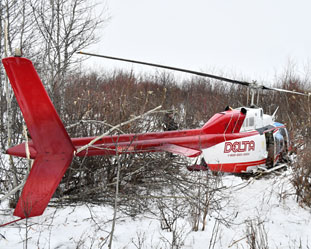Air transportation safety investigation A22W0005
The TSB has completed this investigation. The report was published on 3 August 2022.
Table of contents
Loss of control and collision with terrain
Delta Helicopters Ltd.
Bell 206B JetRanger II (helicopter), C-FCQJ
Camrose Aerodrome, Alberta, 23 NM ESE
The occurrence
On at 1020 Mountain Standard Time, a Bell 206B helicopter registered to Delta Helicopters Ltd. was operating an aerial wildlife survey approximately 23 NM east south east of Camrose Aerodrome, Alberta, with 1 pilot and 3 passengers on board. Approximately 75 minutes into the flight, the helicopter collided with terrain. There was no post-impact fire, and the 406 MHz emergency locator transmitter activated. All occupants sustained serious injuries.
Media materials
News release
Investigation report: January 2022 loss of control and collision with terrain in Camrose, Alberta
Read the news release
Investigation information
Map showing the location of the occurrence
Investigator-in-charge

Jeremy Warkentin joined the Transportation Safety Board of Canada (TSB) in 2017 as a Regional Senior Technical Investigator, in the Aviation Investigations Branch, at the regional office in Edmonton, Alberta.
Mr. Warkentin is a graduate of the British Columbia Institute of Technology’s Aircraft Maintenance Engineer (AME) program and has more than 20 years of aviation experience working for several fixed wing operations as a licensed Aircraft Maintenance Engineer, Quality Assurance Manager and Base/Production Manager. He holds both an M1 and M2 license, and has experience on aircraft ranging in size from the Cessna 152 to the Airbus A321.
Photos
Class of investigation
This is a class 4 investigation. These investigations are limited in scope, and while the final reports may contain limited analysis, they do not contain findings or recommendations. Class 4 investigations are generally completed within 220 days. For more information, see the Policy on Occurrence Classification.
TSB investigation process
There are 3 phases to a TSB investigation
- Field phase: a team of investigators examines the occurrence site and wreckage, interviews witnesses and collects pertinent information.
- Examination and analysis phase: the TSB reviews pertinent records, tests components of the wreckage in the lab, determines the sequence of events and identifies safety deficiencies. When safety deficiencies are suspected or confirmed, the TSB advises the appropriate authority without waiting until publication of the final report.
- Report phase: a confidential draft report is approved by the Board and sent to persons and corporations who are directly concerned by the report. They then have the opportunity to dispute or correct information they believe to be incorrect. The Board considers all representations before approving the final report, which is subsequently released to the public.
For more information, see our Investigation process page.
The TSB is an independent agency that investigates air, marine, pipeline, and rail transportation occurrences. Its sole aim is the advancement of transportation safety. It is not the function of the Board to assign fault or determine civil or criminal liability.
